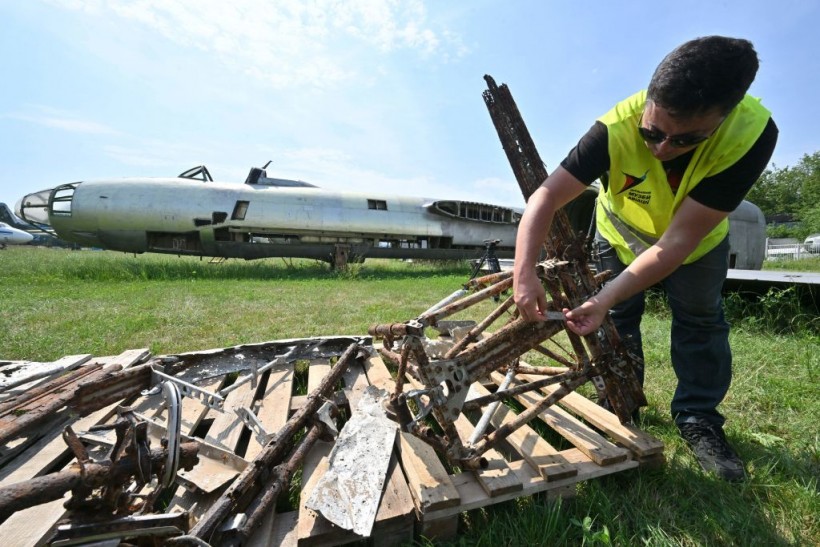In a remarkable find, Ukraine has stumbled upon a collection of deteriorating British fighter aircraft from World War II, hidden underground in a forest near Kyiv. During the German invasion in 1941, Britain dispatched these planes to the Soviet Union as part of a comprehensive military aid package. Allegedly, the United States funded this support through the Lend-Lease program, BBC reported.
Aviation experts highlight that this discovery marks the first instance of unearthing such a significant number of Hawker Hurricanes in Ukraine. Oleks Shtan, a former airline pilot leading the excavation, expressed his astonishment at this exceedingly rare occurrence.

Oleksiy Shtan, senior pilot of Boeing-737 and head of the excavation team, shows remains of a British Hurricane fighter plane during a presentation at an open-air Museum of Aviation in Kyiv, on July 6, 2023.
Vital World War II Fighters
After the end of World War II, the Soviet Union likely buried the rusted and fragmented British Hawker Hurricane aircraft near Kyiv to evade payment to the United States under the Lend-Lease program.
Despite secretive burial, rumors circulated about the discarded planes near an old airfield. Live Science reported that earlier this year the wrecks were discovered after an unexploded wartime bomb was defused nearby, and metal detectors were used to locate them in an underground position.
Volunteers have now unearthed the fighter aircraft wrecks and donated them to the Oleg Antonov State Aviation Museum in Kyiv for preservation and display. Hawker Hurricanes, though overshadowed by the Spitfire fighters, played a vital role in the Allied victory during World War II, with their effectiveness showcased in various theaters and naval operations.
The buried aircraft were part of the 3,000 Hurricanes sent to the Soviet Union, which the United States had purchased from the United Kingdom. The understanding was that the Soviets would repay the U.S. for any intact aircraft at the war's end. The Hurricanes in Kyiv, on the other hand, were stripped of components and dumped in the ravine, allowing the Soviet Union to escape payment.
As per BBC, this discovery provides insights into the wartime history of collaboration and sheds light on the fate of these iconic fighter planes, symbolizing a significant contribution to the Allied effort and the air defense of the United Kingdom during the Battle of Britain.
READ ALSO: Nazi World War II Shipwreck in Belgium Coast Leaks Toxic Explosives and Heavy Metals [STUDY]
Hurricane Fighter Jets a Symbol of British Assistance During World War II
During World War II, Britain sent Hawker Hurricane fighter jets to the Soviet Union as part of allied military support following the invasion by Nazi Germany in 1941, WION reported. The United States financed this aid through the lend-lease scheme, which has parallels with the current military assistance provided by the US to Ukraine in its conflict with Russia.
The Hurricane aircraft were hailed for their strength, ease of flying, and stability as gun platforms, as well as their adaptability for rookie pilots. The freshly discovered rusted remnants of the planes, on the other hand, had been stripped of vital components and useable scrap metal.
While the Hurricane's role was somewhat overshadowed by the Spitfire, it played a crucial part in the Battle of Britain, shooting down more than half of the enemy aircraft during Nazi Germany's attempted invasion of the UK in 1940.
The head of research at the museum highlighted the Hurricanes as symbols of British assistance during World War II and expressed gratitude for the ongoing British support in providing military equipment to Ukraine.
Overall, this discovery not only reveals the historical significance of the Hurricane fighter jets but also serves as a reminder of the longstanding cooperation between Britain and Ukraine in times of conflict.
RELATED ARTICLE: Two Missing World War II B-25 Bombers In Papua New Guinea Studied By Marine Scientists, Archaeologists
Check out more news and information on World War II in Science Times.














